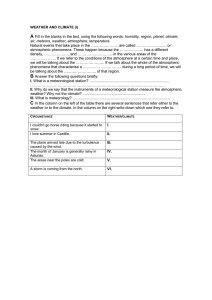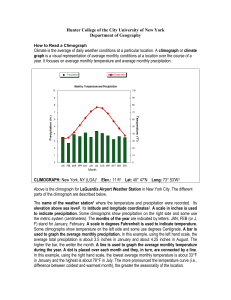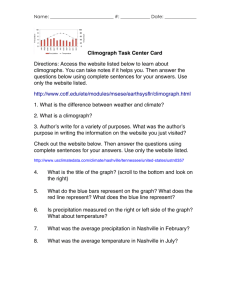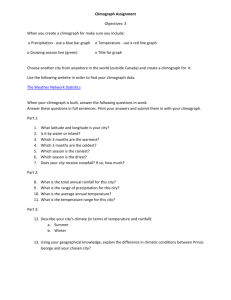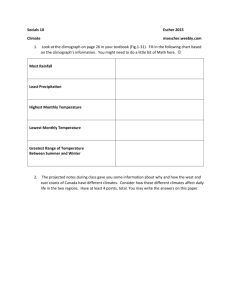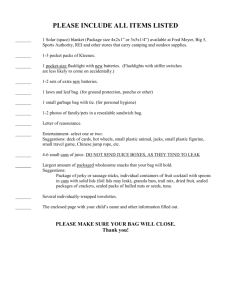E.ES.07.71 Win 10
advertisement
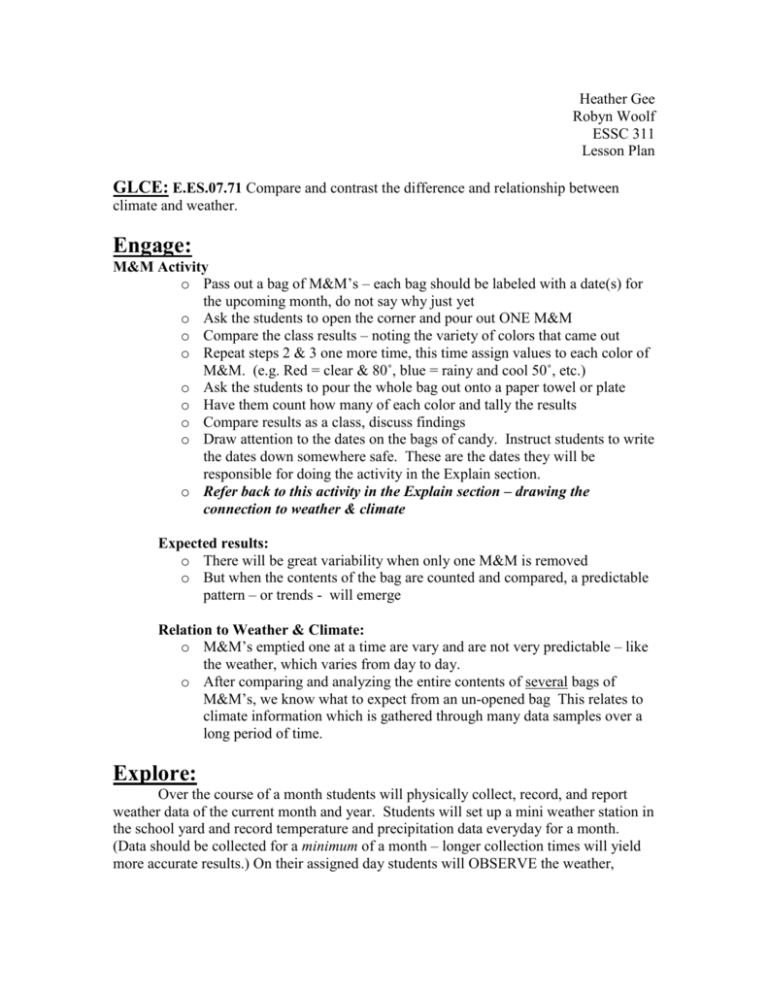
Heather Gee Robyn Woolf ESSC 311 Lesson Plan GLCE: E.ES.07.71 Compare and contrast the difference and relationship between climate and weather. Engage: M&M Activity o Pass out a bag of M&M’s – each bag should be labeled with a date(s) for the upcoming month, do not say why just yet o Ask the students to open the corner and pour out ONE M&M o Compare the class results – noting the variety of colors that came out o Repeat steps 2 & 3 one more time, this time assign values to each color of M&M. (e.g. Red = clear & 80˚, blue = rainy and cool 50˚, etc.) o Ask the students to pour the whole bag out onto a paper towel or plate o Have them count how many of each color and tally the results o Compare results as a class, discuss findings o Draw attention to the dates on the bags of candy. Instruct students to write the dates down somewhere safe. These are the dates they will be responsible for doing the activity in the Explain section. o Refer back to this activity in the Explain section – drawing the connection to weather & climate Expected results: o There will be great variability when only one M&M is removed o But when the contents of the bag are counted and compared, a predictable pattern – or trends - will emerge Relation to Weather & Climate: o M&M’s emptied one at a time are vary and are not very predictable – like the weather, which varies from day to day. o After comparing and analyzing the entire contents of several bags of M&M’s, we know what to expect from an un-opened bag This relates to climate information which is gathered through many data samples over a long period of time. Explore: Over the course of a month students will physically collect, record, and report weather data of the current month and year. Students will set up a mini weather station in the school yard and record temperature and precipitation data everyday for a month. (Data should be collected for a minimum of a month – longer collection times will yield more accurate results.) On their assigned day students will OBSERVE the weather, RECORD the data, compare the data to climate averages and REPORT (NOT forecast) their observations to the class. Start this activity on the first day of the month. At the end of the month, the class will compile and average all the collected data to form climate information. This information can be collected and displayed in a number of ways, one of which is by making a computer generated climograph*. Compare the results to information from a reputable source such as http://www.wunderground.com/. Considerations for weather station: o Make sure the thermometer is not in direct sunlight o Make sure the rain gauge* is not under an overhang or tree o Make sure the objects are secure so that they do not blow over o Take precautions to avoid other students tampering with the equipment o Arrange for data to be collected when school is not in session (weekends, etc) o Record data at a set and appropriate time each day. For example, temperature should not be taken early in the morning, it should be between 12 and 2pm. *Instructions on how to make a rain gauge and a climograph using Microsoft excel attached. Activity Extension Idea: If possible, collaborate with another school in a different climate doing the same activity. Data and findings can be shared via a blog or other electronic means. Expected Results: When compared to climate data, there should be greater variability in the daily weather data the students collect because climate data they will compare their data to represents averages over long periods of time. In addition, climate is weather data collected and averaged over long periods of time. Students will get a small taste of the process. Explain: As a class, the students and teacher will fill in a Venn diagram highlighting the differences and relationships between weather and climate. Students will be allowed to share the knowledge they have constructed first, and then the teacher will fill in any gaps, correct any misconceptions, and introduce and define terminology and concepts. Terminology/ Definitions: Weather Temperature Precipitation/ Trace precipitation Climate* Climograph Climate zones *be sure to note that climate data should be gathered over a minimum of 30 years – the activity in the Explore section was just a small sample of the process. Concepts: Weather varies, can be extreme and uncharacteristic of climates on rare occasions Climate represents the average temp and precipitation over long periods of time Climates can and do change – but over vast time spans Refer back to M&M activity. Draw a connection to one M&M at a time – which varies being like weather and the contents of the bag – which are somewhat predictable – being climate. Elaborate: Students will be asked to choose a vacation destination of their choice and create a travel brochure about that area. The student should research the weather and climate data from the location thoroughly and include the following information: Specific season/ time period for travel Average temperatures and precipitation for the location and specified time of year List of suggested items to pack. Students will write a brief justification of their destination choice and suggested packing list based on weather and climate. Expected results: In their justification, students will demonstrate that they choose their location based on climate information and that the list of suggested items to pack was based on weather that could be very different from the projected climate information. Evaluate: The brochure created in the elaborate section will be evaluated for student understanding. Resources http://cmmap.colosatate.edu http://www.ciese.org/curriculum/weatherproj2/en/docs/raingauge.shtml http://www.nationalgeographic.com/xpeditions/lessons/15/g912/creatingclimograph.pdf http://www.ehow.com/how_5425836_make-gauge-recycled-liter-bottle.html
